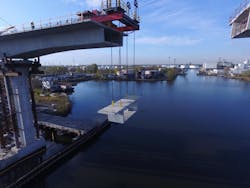Strand Jack Technology Beats Crane in Bridge Cantilever Lift
The recently completed Cline Avenue Bridge in East Chicago, Indiana, crosses the Indiana Harbor and Ship Canal.
Constructing the 316-foot bridge span over the canal, while keeping the canal open to barge traffic, allowed heavy lift specialist Engineered Rigging to prove the flexibility of strand jack technology over a traditional crane approach to completing the span.
The new Cline Avenue Bridge is an elevated expressway that connects the SR 912 to I-90, crossing over the Indiana Harbor and Ship Canal in East Chicago. The bridge is 6,236 feet long with a 316-foot main span over the Indiana Harbor and Ship Canal, providing 100 feet of vertical and 200 feet of horizontal navigational clearance.
Privately-funded project
In the absence of traditional state funding to replace the Cline Avenue Bridge, innovation in its design and construction has been key. The privately funded project has used low-maintenance concrete with an expected lifespan of over 100-years and a mix of traditional and new construction techniques. In total, the bridge comprises 29 cast-in-place concrete columns supporting 685 post-tensioned concrete single cell box girders segments which make up the bridge’s driving deck, with typical spans that vary between 170 feet to 290 feet. The piers range in height from 24 feet to 86 feet.
Assembly of the bridge was based on the balanced cantilever method with precast segments. Cantilevers were erected from the adjacent piers until they were within approximately 4 feet of each other. A cast-in-place closure was inserted, after which continuity tendons were stressed across the joint to complete the span. In total, there are 28 cantilevers and 28 closure joint pours between cantilevers to complete the entire bridge.
The bulk of the cantilever segment lifting and setting was completed using two separate large-capacity, ground-based, cranes. However, tackling the bridge span over the Ship Canal called for a different approach. Beyond the reach of ground-based cranes, some new thinking was required.
Ground-based cranes impractical
The bridge section over the Indiana Harbor and Ship Canal comprises 19 precast segments stretching 380 feet column to column. The width of the canal is 130 feet. Using a crane to lift the segments would have required floating the crane on a barge or using a floating crane to reach the midpoint of the canal span. Aside from the practical challenges of using a floating crane, this approach would have meant closing the canal to barge traffic for a number of weeks. Given the volume of maritime traffic that needs to use the canal, this was not a viable option.
“Cranes are great for lifting heavy objects, but their sheer size and cost often makes them impractical for some applications. Both factors came into play for the Cline Avenue Bridge project. Engineered Rigging was consulted to develop a practical alternative, and our expert engineering team was up for the challenge,” says Christopher Cox, president, Engineered Rigging.
Cox and his team had to take into account factors such as the weight and size of each segment and keeping any disruption to the busy canal to a minimum. The bridge segments measured 10 feet high, 10 feet deep and 25 to 30 feet wide, and weighed 75 tons.
Using strand jack technology
Engineered Rigging’s solution was to build the cantilever segmented bridge span using Enerpac strand jacks to lift the segments into position. While strand jacks are not the quickest lifting method, they provide massive lifting power in a small package. Moreover, they are secure, and their operation makes them essentially fail safe.
The strand jack lifting technique originates from the concrete post-tensioning principle. A strand jack can be considered as a linear winch. In the strand jack, a bundle of steel cables or strands are guided through a hydraulic cylinder; above and below the cylinder are anchor systems with wedges that grip the strand bundle. A split flow pump is used to stroke the cylinders in and out while the grips are engaged in the anchors, a lifting or lowering movement is achieved.
Engineered Rigging developed a customized cantilever segmental bridge lift platform utilizing back span tie downs to counter the cantilever overhanging the bridge. Four 70-ton strand jacks were used to lift the precast bridge segments into place across the waterway. Two beams extended from the platform with two strand jacks mounted on each beam. As each new segment was added the platform was moved forward using a combination of Enerpac launching cylinders and low-height skidding system.
The span construction involved placing the precast segment on a barge on the canal. Simultaneously the strand jack cables were lowered. The barge was moved under the cantilever lift system and each segment corner attached to a strand jack. Over the course of the next 2.5 hours the segment was lifted 130 feet into position. During the final lifting stages, the strand jacks were also used to tilt and manipulate each segment as it was attached to the previous segment. Initially one segment was lifted and installed each day, although when canal traffic was light, up to three segments per day were added.
Synchronized lifting
Engineered Rigging completed the bridge span in just 16 days. Project lead for engineered lifting, Mike Beres, points to the importance of synchronized lifting when using multiple strand jacks. “Enerpac Strand jacks were integral to the safe and on-time completion of the project. They pack tremendous lifting capacity into a small footprint. Moreover, the system software can control up to 60 jack/pump combinations so the potential for synchronous lifting is quite scalable. The flexibility of the strand jack system has allowed Engineered Rigging to use this equipment on many other projects across multiple industries.”
The new 1.7-mile-long Cline Avenue Bridge opened on December 23, 2020. The new bridge cost private operator United Bridge Partners more than $100 million to build as a link to the casinos and steel mills along Lake Michigan. The two-lane bridge is expected to carry 10,000 vehicles daily.
Source: Enerpac
